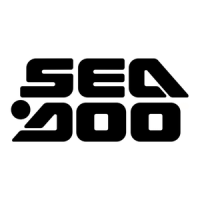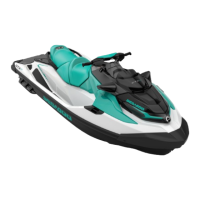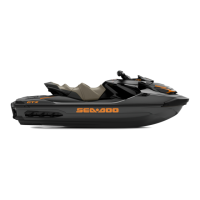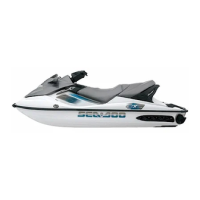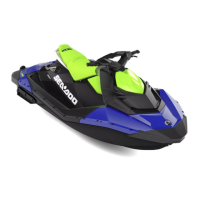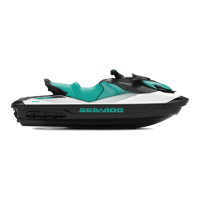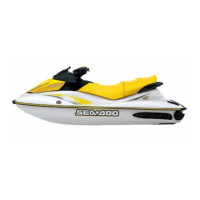How to fix weak spark on SeaDoo Boat?
- MmichaelharmonSep 3, 2025
A weak spark in your SeaDoo Boat can be caused by fouled, defective, or worn spark plugs. Replacing the spark plugs can resolve this issue.
How to fix weak spark on SeaDoo Boat?
A weak spark in your SeaDoo Boat can be caused by fouled, defective, or worn spark plugs. Replacing the spark plugs can resolve this issue.
Why O.P.A.S. side vanes do not go down while engine is at idle on SeaDoo Boat?
If the O.P.A.S. side vanes on your SeaDoo Boat do not go down while the engine is at idle, it could be due to a broken spring inside the side vane cylinder.
Why is my SeaDoo Boat more responsive than usual while turning?
If the SeaDoo Boat is more responsive than usual while turning, it could be because the side vanes do not go up while the watercraft is at speed.
Why does my SeaDoo 2002 GTX 4-TEC Boat pull on one side?
If the SeaDoo Boat pulls to one side, it may be due to one side vane not going up while the watercraft is at speed.
What causes weak spark in SeaDoo 2002 GTX 4-TEC Boat?
A weak spark can be caused by fouled, defective, or worn spark plugs. Replace the spark plugs.
What causes rich fuel mixture in SeaDoo Boat?
A rich fuel mixture in your SeaDoo Boat, leading to high fuel consumption, can be caused by a defective sensor or engine ECU.
What to do if SeaDoo 2002 GTX 4-TEC display shows only P-XXXX numbers?
If your SeaDoo Boat display shows only P-XXXX numbers and no usual numbers, the ECU may have been inadvertently set to onboard diagnostic mode. Remove and reinstall the safety lanyard to resolve this.
What does it mean when my SeaDoo 2002 GTX 4-TEC Boat beeps every 15 minutes?
A 2-second beep every 15 minutes on your SeaDoo Boat can indicate several issues: the watercraft is upside down, or there's a malfunction with the engine coolant temperature sensor, exhaust temperature sensor, engine oil pressure sensor, low pressure in the oil separator tank (engine oil leak), TOPS sensor, TOPS valve solenoid, engine ECU failure, bilge pump circuit (if equipped), or starter solenoid circuit. Turn the watercraft upright to resolve the first potential issue.
What causes lean fuel mixture in SeaDoo Boat?
A lean fuel mixture in your SeaDoo Boat can be caused by a low fuel level, stale fuel, or water-contaminated fuel. It can also be caused by clogged injectors or a defective sensor or engine ECU. Siphon and/or refill the fuel tank to resolve this issue.
What to do if my SeaDoo 2002 GTX 4-TEC engine does not turn over?
If the SeaDoo Boat engine doesn't turn over, several issues could be the cause. Ensure the safety lanyard is correctly installed over the post. Other potential causes include a burnt fuse (main, electric starter, MPEM, or engine ECU), a discharged battery, corroded or loose battery connections, or a water-flooded engine. It could also be due to a faulty sensor, MPEM, or engine ECU, or a seized engine or jet pump. For burnt fuses, check the wiring and replace the fuse(s). For a seized jet pump, attempt to clean it; otherwise, further assistance from a Sea-Doo dealer may be needed.
| Manufacturer | Sea-Doo |
|---|---|
| Model | GTX 4-TEC |
| Year | 2002 |
| Displacement | 1494 cc |
| Horsepower | 155 HP |
| Fuel Type | Gasoline |
| Seating Capacity | 3 |
| Category | Personal Watercraft |
| Engine Type | 4-TEC |
Disregarding safety precautions can lead to injury or death. Operator must inform passengers.
Read Operator's Guide, Safety Handbook, and labels. Complete a safety boating course.
Basic rules for safe operation, age recommendations, and understanding warnings.
Pre-operation checks, protective clothing, directional control, and passenger safety.
Covers defects in material/workmanship for a specified period. Excludes racing use.
Requires purchase from authorized dealer and pre-delivery inspection.
Critical safety warnings regarding PFD, clothing, lanyard, and operation.
Operation of safety lanyard, DESS system, and related warnings.
Description of steering and acceleration controls.
Functions of engine start/stop button and shift lever.
Description of the multifunction information center gauge.
Safe fueling practices and recommended fuel type.
Recommended oil type, viscosity, and how to check oil level.
Step-by-step guide for checking the engine oil level.
Checking coolant level and recommended coolant type.
Duration and throttle usage guidelines for the break-in period.
Recommended dealer inspection after the first 10 hours of operation.
Overview of critical checks to perform before operating the watercraft.
Checking hull for damage and intake for obstructions.
Explanation of how the engine, shaft, and impeller generate thrust.
How to use the shift lever for forward, neutral, and reverse.
How to steer the watercraft and the role of throttle control.
System providing steering assistance during deceleration.
Step-by-step guide for safely starting the engine.
Daily care to prevent marine growth and keep the hull clean.
Essential procedure to flush the exhaust cooling system with fresh water.
How the system monitors components and alerts to faults.
Actions to take for engine overheating and low oil pressure.
How to clean the jet pump intake and impeller.
Procedures for dealing with capsized or submerged watercraft.
Troubleshooting steps for water-flooded and fuel-flooded engines.
Manufacturer's and dealer's responsibilities regarding emission standards.
Schedule and guidelines for routine periodic inspections.
Safe practices for towing the watercraft on a trailer.
Interpreting beeper signals and their possible causes/remedies.
Understanding messages displayed on the information center.
Causes and remedies when the engine fails to crank.
Diagnosing and resolving issues like misfires, smoke, and overheating.
Diagnosing causes for lack of acceleration or power.
Detailed specifications for the engine, lubrication, and exhaust.
